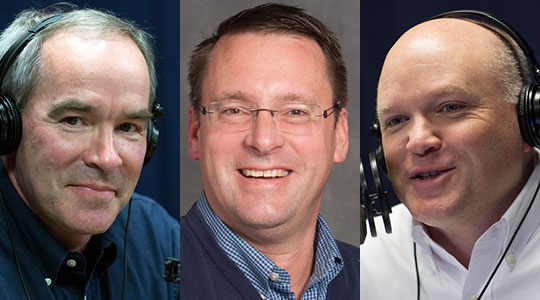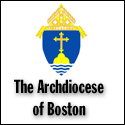Summary of today’s show: Liturgical Publications has been serving Catholic parishes’ communications needs for 40 years and Scot Landry talks with Joe Luedtke and Tim Potrikus about how they are preparing parishes to communicate online through websites and social media and online stewardship while helping their bulletins evolve to continue its role as the most popular communications tool for Catholics.
Listen to the show:
Podcast: Play in new window | Download
Watch the show via live video streaming or a recording later: BostonCatholicLive.com
Today’s host(s): Scot Landry
Today’s guest(s): Joe Luedtke and Tim Potrikus of Liturgical Publications
Links from today’s show:
Today’s topics: Liturgical Publications and it variety of solutions for parishes
1st segment: Scot Landry welcomed everyone to the show. Scot said we like to profile from time to time the leading firms that serve our Church. Today, we profile one of the firms serving not just the Archdiocese of Boston, Liturgical Publications. He welcomed Joe Luedtke and Tim Potrikus. Scot asked Joe how LPI started to serve the Church in 1972. He said they started in Milwaukee, a father and son printing bulletins just for a few churches. They now cover most of the central, northeast, and some of the western United States and have 4,100 parish customers for their church bulletins. About 4 years ago, they saw how the Internet is starting to affect how people consume information and they knew the Church will be changing how people consume information and started a few new technology initiatives.
Scot said there are 18,000 parishes in the US and LPi serves about 150 parishes in the Archdiocese of Boston. They’ve been here over the past 30 years. Tim said when he began in 1992, his job was to go to churches and have them sign agreements for bulletin services. They were taking parishes from typewriters and glue sticks and exacto knives to Word 5.1 for DOS. They realized that the work the secretary did for the bulletin was just a side job, so they brought their skills to answering those needs and responding to their questions as quickly and comprehensively as possible.
Scot asked how many in the average parish get their information from the different media. Joe said for the average Catholic, he bulletin remains the standard way of parishes communicating to the parishes. Even on the parish websites, the bulletin is the most frequently accessed piece of content. It also says something about the state of Church communications online. In many cases, the parish website is not the best form of communication as parishes struggle to keep them updated and fresh. In the long run, as parishes adopt better websites, that will change. Parishioners’ behavior is changing online. LPi hosts about 350 parish websites online and they see about 21% of all requests to these websites are coming from smartphones and another 10% from iPads and other tablets.
Scot said his sense was when he was young that people used bulletins or the telephone to get information about the parish and that’s moving increasingly to the web. In 10 or 15 years, Scot thinks the bulletin will still be around, even if it’s used differently, without including every announcement and all the contact information. Joe said 5 or 10 years from now, the bulletin isn’t going away. It will remain a staple of church communication. LPi has called it connecting your community and they view it as happening both in print and online. Email communication will be more important with email newsletters going out to every parishioner, not just those who made it to Mass this weekend. Joe can’t predict more than 10 years out. He’s planning for print to be around 10 or 20 years from now, but we can’t discount the presence of print, even if we can’t predict technology.
Tim said they’re now advocating as bulletins not having a cover, but a page one, like a newspaper with the headline news and current events on the front page. the first thing that people see is most important. that type of information on the front-page makes a difference in readership and the use of content.
2nd segment: Tim said his mom is a typical daily Mass Catholic and he and his whole family was brought up Catholic. She still reads the bulletin and diocesan newspaper. For Tim and his wife, they still get the bulletin too. As his kids grew up, he signed them up to receive the parish bulletin via email. He’s also downloaded a video from Fr. Dave Dwyer of Busted Halo on Advent in 2 minutes that he emailed to his kids. His daughter asked why the priest never said it like that when they were growing up.
Scot said Pope Benedict has made his World Day of Communications message about reaching people with one foot in the Church and one foot in the new media in a way that reaches them. Joe said these messages gives us credence that we are headed down the right path. It is difficult o see sometimes where the world is going and there is both good and bad on the Internet. There are often concerns raised about data privacy and defamatory content on social media. But hearing the Pope push use to that digital continent, the Internet, encourages us down that path.
Joe said LPi views the Internet as twofold. Every parish needs a website as the marketing face of the church on the Internet for the general public, parishioners, and occasional parishioners. The most common search is still the basic information, like Mass times. The number one thing they push is making the content as easy to maintain as possible. Churches don’t have staff to hire developers and content managers. So if someone knows how to use Microsoft Word, they will know how to use their website product, WeConnect. They also believe in engagement through social media. This is different than marketing. They believe that Facebook and Twitter are marketing to the world, while their product WeGather is for just the parish social network. It’s a closed website just for parishioners that encourage them to communicate and coordinate. It helps the church engage their parishioners online. The average American spends two to four hours per day online and starting to surpass TV. They hope this will help parishes connect with parishioners online.
They now also have WeShare, an online giving product. It came from WeGather, as parishes asked for ways to organize events and receive payments for them. They first added payment functionality into WeGather and then they built into an online donation product within WeGather and that grew beyond WeGather. Joe noted that for many people the only checks they write is to their parish and school.
Scot said he views the parish website as the parish’s virtual front door and asks people to imagine driving down the street and seeing graffiti and a poorly maintained yard in front of the church. This would deter many people from coming in. The same with websites. People wonder if any of the information is accurate when the whole website looks like no one has been maintaining it. Tim agreed that it doesn’t give people the sense of how lively and active the parish is.
Scot talked about the different types of information sought by the different audiences, general public, regular parishioners, and newcomers. He asked Joe who he thinks the parish website editor focuses on the most when building the website. Joe said it is a marketing tool. Churches do make the mistake of designing for not just the average parishioner, but the committed parishioners. On some sites, the most promoted content on the site is the history of the church. For most people, they won’t be interested in that level of detail. We need to design websites for the typical parishioner and non-parishioner. Once you have some content on your parish homepage, ask your neighbor—especially if they’re not Catholic—what that website says to them.
3rd segment: Scot asked Joe about WeGather and what feedback they get from parishioners on what they like most about it. Joe said once it starts to take off, it typically starts with one or two groups using it to communicate agendas and meeting minutes. Then they see parishioners communicating directly with parishioners, talking about both faith topics, but also the general community. They connect with each other. For example, a group of moms use it to plan playdates. They have replaced phone calls and email and it brings it to the attention to the rest of the community what else is going on.
Joe said you can do some of the same things on Facebook and Google+, but those can be too open. Many parishes when starting are worried about negative postings. They don’t censor proactively, although an administrator can delete later. However, on WeGather people are talking to fellow parishioners on an account approved by the parish and using their real name. It’s not anonymous, which is one of the reasons why there’s so much negativity online.
How difficult is it to convince parishioners to sign up and use WeGather? How does LPi help the parish create a critical mass. Joe said the hardest part is getting started. You need some content to bring the site to life. They start with one volunteer group within the parishes that’s active, especially one that’s struggling to communicate. Some churches have a large home and school group or a men’s group or women’s group with a couple hundred. That gets unwieldy to manage through email. WeGather eliminates it immediately. As a member of WeGather, you can either log on to access the site or elect to receive a daily or weekly summary of what’s happening in your groups. This gives the parishioners flexibility. Email is still the number one form of communication online.
Tim added that there’s a widget that also allows you to automatically put information from WeGather right on the church website automatically. Scot said he’s found it takes a while for parishes to adopt new ideas and many want to see that the product is mature and the bugs have been worked out by others. Joe said they have about 500 parishes signed up to use WeGather. It’s free to sign up. Of the 500, probably about half have had good success. The other half have seen struggles engaging parishioners. These are just tools. Engagement has to come from the parish. They almost need a technical evangelist within the church to help bring the community to life.
For anything to become part of the culture of a group, it needs to be talked about frequently, not just by the leaders, but also by someone who uses it as a member of a ministry.
Moving onto WeShare, which helps with stewardship. Scot said stewardship has bad connotation of asking for money without asking. But it’s really a rich aspect of Catholic theology of understanding our gifts from God through prayerfully considering how we should give back to God in the Church and how much. Tim said it’s not enough to put the Visa sign up. People want to give to people and they need to tell the story of the good work being done by the parish. They are bringing the tools together to tell the story of what the parish is about.
Scot said online giving is growing quickly in terms of the amount of money given, but slowly based on the percentage of total parishioners, especially compared to percentage of those people paying bills online. Joe said the first reason is mistake that he’s seen parishes make. When parishes think of online giving they think of their own bank. They often create an EFT program with a paper form to be filled out by parishioners. Only one to two percent of parishioners will respond to that. The reality is that most want to manage their finances. They worry about data privacy and worry about putting their data on a form. People want to be able to make changes without having to go into the parish office to make the change.
Scot said five or six years ago there were not a lot of Catholic solutions to online giving. In the last couple of years, Catholic organizations like Our Sunday Visitor and LPi have come out with solutions. They’ve worked with parish business managers for many years and understand what parishioners are looking for and know what they want from them. It’s easy for pastors to say they trust LPi. Tim said LPi also has the technical resource, where parishes can still call the same people they always have. And parish secretaries have the ability to create new offerings on the fly with information on how the donations will be used.
Scot said all the products from LPi are approved by the Archdiocese of Boston for use by its parishes. He asked Joe how much money comes through online giving in parishes that have WeShare. Joe said their initial goal in parishes in 20% adoption rise and expect to see it rise 10-20% each year after that. Tim said individuals are increasing 10 to 25% their own donations. Part of this is just helping people give every single week, including when they’re not at their own parish on a particular weekend.








Comments Closed